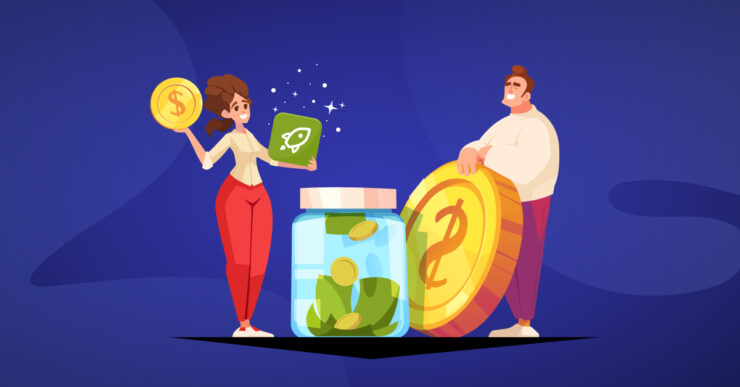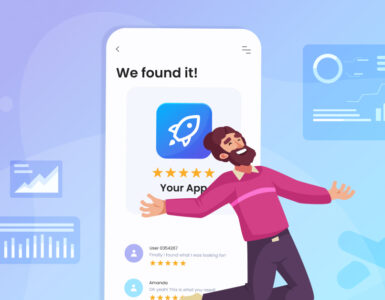In the world of mobile apps, the pursuit of effective app monetization has become a major challenge for developers and marketers. Mobile apps have evolved from simple tools to integral components of our daily lives, offering convenience, entertainment, and solutions to a variety of needs. As the app market continues to expand, developers are faced with the challenge of developing strategies to diversify revenue streams to ensure sustainable success in an increasingly competitive environment. This comprehensive article examines various monetization methods, focusing on in-app purchases (IAPs) and advertising, and explores innovative methods for generating revenue.
Below in the graph we see data from the Statista service, which shows the growth of spending in users’ mobile applications.
Here are some key takeaways from the data:
- Global consumer spend on mobile apps is expected to reach $189 billion in 2023, up from $170 billion in 2021.
- The Google Play Store is the larger of the two app stores, with expected revenue of $116 billion in 2023.
- Games are the most popular category of apps, accounting for over half of all consumer spend.
- Social and entertainment apps are also major drivers of mobile spending.
The Evolution of App Monetization
The traditional model of upfront payments for app downloads has given way to monetization approaches. The advent of app stores’ freemium models, offering free app downloads with optional in-app purchases (IAPs), has transformed the revenue landscape. Today, developers have an array of monetization strategies at their disposal, catering to diverse user preferences and market demands.
In-App Purchases (IAPs)
In-app purchases entail users buying digital goods or services within the app, enhancing their experience or unlocking exclusive features. These purchases can be categorized as consumable (e.g., virtual currency, power-ups), non-consumable (e.g., premium features, ad removal), or subscriptions (e.g., premium content, ad-free experience).
- Freemium Model: This model involves offering the app for free while providing additional perks or content behind a paywall. Many games utilize this model, providing free gameplay but charging for extra lives, boosts, or exclusive items.
- Subscription Services: Content-based apps, such as streaming services, news platforms, or fitness apps, commonly adopt subscription models. Providing access to premium content, ad-free experiences, or additional features on a recurring basis creates a steady revenue stream.
- Consumable Items: Games and productivity apps offer consumable items like virtual currency, extra lives, or power-ups for purchase, enticing users with enhanced experiences or faster progress.
- Unlockable Content: Some apps allow users to unlock additional levels, features, or functionalities for a one-time purchase, enhancing user engagement and retention.
Implementing in-app purchases requires a delicate balance between enticing users with valuable offerings and avoiding alienating those who prefer free experiences.
Transparency, offering genuine value, and maintaining a seamless purchasing process are key elements for success.
Advertising Monetization
Advertising – main app monetization. Various ad formats cater to different app types and user experiences:
- Banner Ads: Displayed across the app interface, these ads are usually static or animated, directing users to the advertiser’s content when clicked. However, they can disrupt user experience if not integrated thoughtfully.
- Interstitial Ads: Full-screen ads that appear at natural break points within the app, such as between levels in a game or during transitions. They provide higher visibility but should be timed carefully to avoid annoyance.
- Video Ads: Short video clips that users watch in exchange for in-app rewards or access to premium content. They offer high engagement but must strike a balance between length and user tolerance.
- Native Ads: Seamlessly integrated into the app’s design, native ads blend with the content, appearing less intrusive and enhancing user experience. They often perform better due to their non-disruptive nature.
- Reward-based Ads: Users voluntarily watch ads to gain in-app rewards, encouraging engagement while providing an opt-in experience.
Developers must consider user preferences and ad placement to ensure ads complement the app experience without compromising usability. Moreover, maintaining a balance between ad frequency and user engagement is crucial to avoid driving users away.
Other Monetization Strategies
Beyond in-app purchases and advertising, alternative monetization strategies exist:
- Affiliate Marketing: Partnering with brands or services and earning commissions for driving app users to make purchases or sign-ups.
- Sponsorships and Partnerships: Collaborating with brands for product placements or sponsored content within the app.
- Data Monetization: leveraging user data (with user consent) to provide insights or targeted advertising.
Licensing and White Labeling: Licensing app technology or offering white-labeled versions of the app to other businesses for a fee.
Accelerate monetization by ranking in the App Store
Achieving a prominent position in app stores greatly speeds up the monetization process for mobile apps. Securing a place in the top 250 rankings (the higher the better) increases the app’s visibility and user engagement. Keyapp offers a strategic way to speed up this process by allowing you to purchase app installs using specific keywords. With this service, apps rank higher in search rankings for targeted keywords, increasing organic downloads among users who are genuinely interested in what the app has to offer. However, the success of this approach largely depends on choosing the right keywords. Earlier in our article, we discussed the importance of choosing the right keywords, highlighting how they impact app visibility and user acquisition. In this article, you can get detailed information about keyword optimization to increase app visibility and attract the right audience.
Conclusion
Diversifying revenue streams within mobile apps is pivotal for long-term sustainability and growth. A successful monetization strategy often involves a combination of approaches tailored to the app’s nature, audience, and market trends. Whether through in-app purchases, advertising, or innovative strategies like affiliate marketing or data monetization, developers must prioritize user experience, providing value while generating revenue. Adapting to changing user preferences and market dynamics remains essential in the dynamic landscape of app monetization. Ultimately, the most effective strategies seamlessly integrate monetization methods while prioritizing user satisfaction, fostering a mutually beneficial relationship between developers and users in the ever-expanding mobile app ecosystem.























